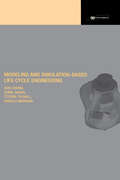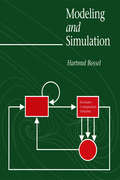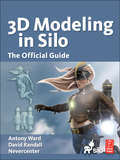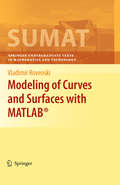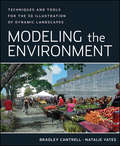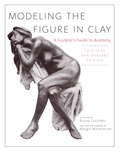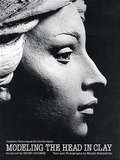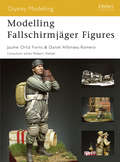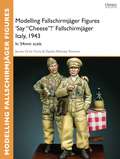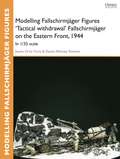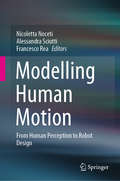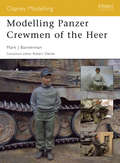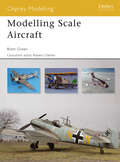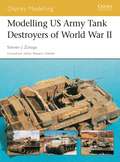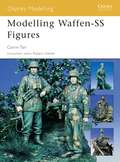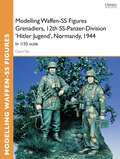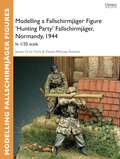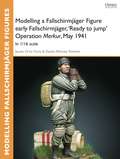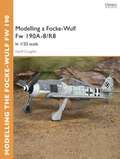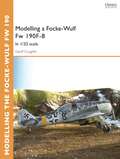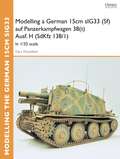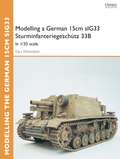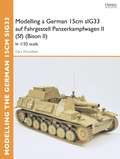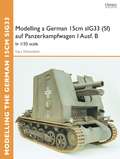- Table View
- List View
Modeling and Simulation Based Life-Cycle Engineering
by Ken Chong Harold S. Morgan Sunil Saigal Stefan ThynellAdvances in computational power have facilitated the development of simulations unprecedented in their computational size, scope of technical issues, spatial and temporal resolution, complexity and comprehensiveness. As a result, complex structures from airplanes to bridges can be almost completely based on model-based simulations. This book gives
Modeling and Simulation: Stochastic And Control Systems, Pattern Recognition, Fuzzy Analysis, Simulation, Behavioral Models (Interdisciplinary Systems Research Ser.)
by Hartmut BosselModels and simulations of all kinds are tools for dealing with reality. Humans have always used mental models to better understand the world around them: to make plans, to consider different possibilities, to share ideas with others, to test changes, and to determine whether or not the development of an idea is feasible. The book Modeling and Simulation uses exactly the same approach except that the traditional mental model is translated into a computer model, and the simulations of alternative outcomes under varying conditions are programmed on the computer. The advantage of this method is that the computer can track the multitude of implications and consequences in complex relationships much more quickly and reliably than the human mind. This unique interdisciplinary text not only provides a self contained and complete guide to the methods and mathematical background of modeling and simulation software (SIMPAS) and a collection of 50 systems models on an accompanying diskette. Students from fields as diverse as ecology and economics will find this clear interactive package an instructive and engaging guide.
Modeling in Silo: The Official Guide
by David Randall Antony Ward NevercenterCreate high-quality models in no time at all with these comprehensive, full-color, techniques and tutorials from Antony Ward and David Randall. These step-by-step tutorials walk readers through the creation of a high-quality female model while teaching you the basics and principles behind 3D modeling in Silo - including modeling the face and clothes, creating textures, and posing the character. The companion website includes all of the tutorial and project files. This book is officially endorsed and co-written by the creators of Silo, Nevercenter. Features include:
Modeling of Curves and Surfaces with MATLAB®
by Vladimir RovenskiThis text on geometry is devoted to various central geometrical topics including: graphs of functions, transformations, (non-)Euclidean geometries, curves and surfaces as well as their applications in a variety of disciplines. This book presents elementary methods for analytical modeling and demonstrates the potential for symbolic computational tools to support the development of analytical solutions. The author systematically examines several powerful tools of MATLAB® including 2D and 3D animation of geometric images with shadows and colors and transformations using matrices. With over 150 stimulating exercises and problems, this text integrates traditional differential and non-Euclidean geometries with more current computer systems in a practical and user-friendly format. This text is an excellent classroom resource or self-study reference for undergraduate students in a variety of disciplines.
Modeling the Environment
by Bradley Cantrell Natalie YatesA single-source guide to harnessing the power of 3D visualization tools for analysis and representation of landscapes Current technology allows designers to model environmental phenomena and space in new and exciting ways that go beyond the two-dimensional plane. The models, illustrations, and animations that can be created usher in a new paradigm of landscape representation that can become analytical tools as well as beautiful imagery. The text focuses on digital modeling methods that can be used to express rich environments using digital tools to develop, composite, and animate scenes. This full-color book provides coverage of 3D visualization tools for land planning and landscape architecture. The methods and theories in Modeling the Environment present landscape representation around a core set of ideas-scene, object, terrain, environment/atmosphere, time/dynamics, and the composite-that centers representation on human experience. Supported by www. lab. visual-logic. com, a website offering tutorials and forums, the text shows you how to use Autodesk 3ds Max to create dynamic landscape environments while also referring to a range of other tools including Google SketchUp, Autodesk Maya, and AutoCAD Civil 3D. It also demonstrates how to integrate 3D visualization tools into existing workflows, and offers critical coverage of intelligent drawings and representations, giving you a glimpse at the future of the profession. This book: Includes sections intended to build upon one another in order to understand the environment as a composite representation of multiple systems interacting Shows how to integrate 3D visualization tools into existing workflows, as opposed to offering an entirely new workflow Emphasizes modeling, animation, and simulation as both design analysis tools and presentation tools Modeling the Environment is essential reading for professionals in landscape architecture, urban planning and design, architecture, and related disciplines who are looking to be at the forefront of technology.
Modeling the Figure in Clay, 30th Anniversary Edition
by Margit Malmstrom Bruno LucchesiFor thirty years, Modeling the Figure in Clay has been an indispensable anatomical resource for people who think, see, and understand form best in the round: sculptors. In the thirtieth anniversary edition of this classic work, master sculptor Bruno Lucchesi invites you on a guided tour of the human form. Follow him as he creates a figure in clay--literally from the inside out--starting with the skeleton, laying on the muscles to show male and female anatomy, and finishing with a complete figure sculpture with every detail of face and hair carefully modeled. BRUNO LUCCHESI's work has been added to the collections of the Whitney Museum of American Art, the Brooklyn Museum, and the Dallas Museum, among many others. Lucchesi has received awards from the National Academy, the National Arts Club, and the Architectural League. He was a Guggenheim Fellow in 1962-1963, he won a Gold Medal award from the National Academy of Design in 1990, and was awarded the Polich Tallix Foundry Prize from the National Sculpture Society in 2009.From the Trade Paperback edition.
Modeling the Head in Clay
by Margit Malmstrom Bruno LucchesiCreative techniques step-by-step. This book offers the reader an opportunity to watch one of our foremost contemporary sculptors at work, to see not just highlights of the creative process, but every step from beginning to end.In order to recreate the immediacy of an actual workshop situation, Bruno Lucchesi takes a single life-size head through all the stages of roughing in, modeling, refining the surface, and finishing and texturing, so that the reader can see exactly how he positions and models every detail.From the Trade Paperback edition.
Modelling Fallschirmjäger Figures
by Jaume FornsThe German Fallschirmj¿ger were elite soldiers, a factor that continues to ensure their popular appeal today, particularly among modellers. There are many Fallschirmj¿ger figures on the market, in plastic, metal and resin, and in all three of the most popular scales - 1/35, 1/32 (54mm), and 1/15 or 1/16 (120mm). Manufacturers currently produce figures related to every major campaign they were involved in. This is the first book to address the subject of German paratroopers for the figure modeller. All the major items of Fallschirmj¿ger uniform and equipment are covered, with an emphasis on specially designed paratrooper items. Camouflage uniforms were prominent among these units, with several patterns employed, and these are particularly attractive to the figure painter. Clear step-by-step instructions allow the reader to recreate these patterns in miniature with confidence and ease. This book will be of interest to all figure modellers, and to AFV modellers too, with the techniques explained easily transferrable to other scales. It covers painting, superdetailing, and conversion techniques (from simple to advanced), and key aspects of scene creation and setting, such as groundwork, balance, and composition, with projects ranging from single-figure studies to full-scale dioramas. Each chapter develops the modelling techniques in a progressive manner, as well as revealing the chronological development of Fallschirmj¿ger uniforms and equipment in sequence. This highly accessible book makes use of commercially available figures, from different firms and in different materials. Jaume and Daniel's superb presentation skills are brought to the fore in this visually detailed, packed and engaging treatment of one of the most enduring figure-modelling subject areas.
Modelling Fallschirmjäger Figures 'Say "Cheese"!' Fallschirmjäger Italy, 1943
by Jaume FornsThis is one of four guides addressing the subject of modelling a German Fallschirmjäger figure model. The major items of Fallschirmjäger uniform and equipment are covered, with an emphasis on specially designed paratrooper items. Clear step-by-step instructions allow the reader to recreate realistic figures in miniture scale with confidence and ease. Among the tutorials covered in this guide are face painting, creating complex camouflage patterns, weathering clothing, and figure conversion techniques, as well as vignette and diorama settings for your figures (creating groundwork and balancing composition). This title provides a detailed, step-by-step guide to modelling a Fallschirmjäger in Italy, 1943. It also provides a comprehensive list of available aftermarket products and kits of all scales. This guide forms part of Osprey Modelling 31 Modelling Fallschirmjäger Figures ebook.
Modelling Fallschirmjäger Figures 'Tactical withdrawl' Fallschirmjäger on the Eastern Front, 1944
by Jaume FornsThis is one of four guides addressing the subject of modelling a German Fallschirmjäger figure model. The major items of Fallschirmjäger uniform and equipment are covered, with an emphasis on specially designed paratrooper items. Clear step-by-step instructions allow the reader to recreate realistic figures in miniture scale with confidence and ease. Among the tutorials covered in this guide are face painting, creating complex camouflage patterns, weathering clothing, and figure conversion techniques, as well as vignette and diorama settings for your figures (creating groundwork and balancing composition). This title provides a detailed, step-by-step guide to modelling a Fallschirmjäger on the Eastern Front, 1944. It also provides a comprehensive list of available aftermarket products and kits of all scales. This guide forms part of Osprey Modelling 31 Modelling Fallschirmjäger Figures ebook.
Modelling Human Motion: From Human Perception to Robot Design
by Nicoletta Noceti Alessandra Sciutti Francesco ReaThe new frontiers of robotics research foresee future scenarios where artificial agents will leave the laboratory to progressively take part in the activities of our daily life. This will require robots to have very sophisticated perceptual and action skills in many intelligence-demanding applications, with particular reference to the ability to seamlessly interact with humans. It will be crucial for the next generation of robots to understand their human partners and at the same time to be intuitively understood by them. In this context, a deep understanding of human motion is essential for robotics applications, where the ability to detect, represent and recognize human dynamics and the capability for generating appropriate movements in response sets the scene for higher-level tasks. This book provides a comprehensive overview of this challenging research field, closing the loop between perception and action, and between human-studies and robotics. The book is organized in three main parts. The first part focuses on human motion perception, with contributions analyzing the neural substrates of human action understanding, how perception is influenced by motor control, and how it develops over time and is exploited in social contexts. The second part considers motion perception from the computational perspective, providing perspectives on cutting-edge solutions available from the Computer Vision and Machine Learning research fields, addressing higher-level perceptual tasks. Finally, the third part takes into account the implications for robotics, with chapters on how motor control is achieved in the latest generation of artificial agents and how such technologies have been exploited to favor human-robot interaction. This book considers the complete human-robot cycle, from an examination of how humans perceive motion and act in the world, to models for motion perception and control in artificial agents. In this respect, the book will provide insights into the perception and action loop in humans and machines, joining together aspects that are often addressed in independent investigations. As a consequence, this book positions itself in a field at the intersection of such different disciplines as Robotics, Neuroscience, Cognitive Science, Psychology, Computer Vision, and Machine Learning. By bridging these different research domains, the book offers a common reference point for researchers interested in human motion for different applications and from different standpoints, spanning Neuroscience, Human Motor Control, Robotics, Human-Robot Interaction, Computer Vision and Machine Learning.Chapter 'The Importance of the Affective Component of Movement in Action Understanding' of this book is available open access under a CC BY 4.0 license at link.springer.com.
Modelling Panzer Crewmen of the Heer
by Mark BannermanAdding a figure to a kit or display can increase both depth and interest, yet building and painting figures continues to be a source of frustration to many armour modelers. This book provides full details on how to build and integrate realistic Heer Panzer crew figures with their vehicles, and on how to paint the key uniform variants and patterns worn by these distinctive troops. It begins with a brief discussion of the various mediums (plastic, resin and white metal), and a round up of the tools, materials and aftermarket items suitable for building and super-detailing figures. Using differing theatres and periods of the war, it shows how to paint common clothing types and patterns, such as the black panzer uniform, Splittermuster, feldgrau, and fatigues, as well as unique and fascinating variants such as Russian camouflage fabric and the motorcycle rubber coat. Special effects, such as dust-covering, and the addition of equipment and and other details are also covered in clear, step-by-step tutorials. The book will also challenge and inspire the more experienced crew figure modeler, with clearly explained 'kit-bashing' and scratch-building demonstrations, making this a treatment of the subject with wide appeal.
Modelling Scale Aircraft
by Brett GreenBrett Green, one of the hobby's leading names, provides a comprehensive introduction to all of the basic techniques and materials needed to build scale aircraft, from first opening the kit box to displaying the finished model - all in one clear and easy-to-follow expert guide. The many detailed photographs with step-by-step captions, and the accessible and informative text cover every aspect of aircraft kit construction from initial preparation through all stages of assembly to detailed finishing. This is an essential resource for the novice aircraft modeller.
Modelling US Army Tank Destroyers of World War II
by Steven ZalogaTank destroyers were the US Army's response to blitzkrieg, and were based around the concept of mounting a large anti-tank gun on a light, fast moving vehicle. They served in the Mediterranean, Pacific, and North-West Europe theatres, and were also supplied to other Allied armies. These vehicles form an attractive modelling subject; their open turrets provide plenty of opportunity for detail work, as demonstrated here by the author in clear step-by-step instructions. Packed with tips and techniques from a leading modeller and Allied armour expert, this title covers the M10, M18, M36, and M39, and features modelling projects in 1/35th and 1/72nd scale.
Modelling Waffen-SS Figures
by Calvin TanThis book explores the main patterns of Waffen-SS camouflage and dress and describes how to achieve these finishes in clear, step-by-step instructions. Advanced figure sculpting techniques, including conversions, are also featured, providing plenty of detail and diverse challenges to modellers of different abilities. Calvin Tan's superb base artwork and multi-layered painting technique are highlighted in this visually detailed, packed and engaging treatment of one of the most enduring, popular figure-modelling subject areas. The featured subjects include an SS-Sturmmann, an SS-Scharführer, and SS-Schütze, and a Panzergrenadier machine-gunner.
Modelling Waffen-SS Figures Grenadiers, 12th SS-Panzer-Division 'Hitler Jugend', Normandy, 1944
by Calvin TanWritten by one of the world's leading figure modellers, this guide features a main pattern of Waffen-SS camouflage and dress and describes in clear, step-by-step instructions how to achieve these finishes. Advanced figure sculpting techniques, including conversions, are also covered, providing plenty of detail and diverse challenges to modellers of different abilities. Calvin Tan's superb base artwork and his multi-layered painting technique are brought to the fore in this visually detailed and engaging treatment of one of the most popular figure-modelling subject areas. This title provides a detailed, step-by-step guide to modelling Grenadiers, 12th SS-Panzer-Division 'Hitler Jügend', Normandy, 1944. It also provides a comprehensive list of available aftermarket products and kits of all scales. This guide forms part of Osprey Modelling 23 Modelling Waffen-SS Figures ebook.
Modelling a Fallschirmjäger Figure 'Hunting Party' Fallschirmjäger, Normandy, 1944
by Jaume FornsThis is one of four guides addressing the subject of modelling a German Fallschirmjäger figure model. The major items of Fallschirmjäger uniform and equipment are covered, with an emphasis on specially designed paratrooper items. Clear step-by-step instructions allow the reader to recreate realistic figures in miniture scale with confidence and ease. Among the tutorials covered in this guide are face painting, creating complex camouflage patterns, weathering clothing, and figure conversion techniques, as well as vignette and diorama settings for your figures (creating groundwork and balancing composition). This title provides a detailed, step-by-step guide to modelling a Fallschirmjäger, Normandy, 1944. It also provides a comprehensive list of available aftermarket products and kits of all scales. This guide forms part of Osprey Modelling 31 Modelling Fallschirmjäger Figures ebook.
Modelling a Fallschirmjäger Figure early Fallschirmjäger, 'Ready to jump' Operation Merkur, May 1941
by Jaume FornsThis is one of four guides addressing the subject of modelling a German Fallschirmjäger figure model. The major items of Fallschirmjäger uniform and equipment are covered, with an emphasis on specially designed paratrooper items. Clear step-by-step instructions allow the reader to recreate realistic figures in miniture scale with confidence and ease. Among the tutorials covered in this guide are face painting, creating complex camouflage patterns, weathering clothing, and figure conversion techniques, as well as vignette and diorama settings for your figures (creating groundwork and balancing composition). This title provides a detailed, step-by-step guide to modelling an early Fallschirmjäger, Operation Merkur, May 1941. It also provides a comprehensive list of available aftermarket products and kits of all scales. This guide forms part of Osprey Modelling 31 Modelling Fallschirmjäger Figures ebook.
Modelling a Focke-Wulf Fw 190A-8/R8
by Geoff CoughlinThe Focke-Wulf Fw 190 is regarded as one of the best fighters of World War II. Designed by Kurk Tank, it first saw combat in the summer of 1941 and went on to be produced in several variants. It remains hugely popular subject for aviation scale-modellers. This title provides a detailed, step-by-step guide to modelling the Focke-Wulf Fw 190A-8/R8 in 1/32 scale. Key aspects such as finishing techniques, including painting and displaying your model are covered. This guide forms part of Osprey Modelling 27 Modelling the Focke-Wulf Fw 190 A, F and G also available as an ebook.
Modelling a Focke-Wulf Fw 190F-8
by Geoff CoughlinThe Focke-Wulf Fw 190 is regarded as one of the best fighters of World War II. Designed by Kurk Tank, it first saw combat in the summer of 1941 and went on to be produced in several variants. It remains hugely popular subject for aviation scale-modellers. This title provides a detailed, step-by-step guide to modelling the Focke-Wulf Fw 190F-8 in 1/32 scale. Key aspects such as finishing techniques, including painting and displaying your model are covered. This guide forms part of Osprey Modelling 27 Modelling the Focke-Wulf Fw 190 A, F and G also available as an ebook.
Modelling a German 15cm sIG33 (Sf) auf Panzerkampfwagen 38(t) Ausf.H (SdKfz I38/I)
by Gary EdmundsonThe 'Bison' and Grille' are today's commonly used names for the German self-propelled 15cm schwere Infanteriegeschütz 33 (sIG33) vehicles of World War II. The sIG33 was the most powerful support weapon for the German infantry at the beginning of the war, and from 1940 it was mounted on a range of tracked vehicles. This title provides a detailed, step-by-step guide to modelling a 1/35-scale German self-propelled sIG33 Vehicle. The modeller is led through the various skill levels of construction by combining existing kits with some aftermarket accessories and scratch-built items. Key aspects such as finishing techniques, including painting and displaying your model are also covered. This guide forms part of Osprey Modelling 19 Modelling the German 15cm sIG33 Bison and Grille ebook.
Modelling a German 15cm sIG33 Sturminfanteriegeschütz 33B
by Gary EdmundsonThe 'Bison' and Grille' are today's commonly used names for the German self-propelled 15cm schwere Infanteriegeschütz 33 (sIG33) vehicles of World War II. The sIG33 was the most powerful support weapon for the German infantry at the beginning of the war, and from 1940 it was mounted on a range of tracked vehicles. This title provides a detailed, step-by-step guide to modelling a 1/35-scale German self-propelled sIG33 Vehicle. The modeller is led through the various skill levels of construction by combining existing kits with some aftermarket accessories and scratch-built items. Key aspects such as finishing techniques, including painting and displaying your model are also covered. This guide forms part of Osprey Modelling 19 Modelling the German 15cm sIG33 Bison and Grille ebook.
Modelling a German 15cm sIG33 auf Fahrgestell Panzerkampfwagen II (Sf) (Bison II)
by Gary EdmundsonThe 'Bison' and Grille' are today's commonly used names for the German self-propelled 15cm schwere Infanteriegeschütz 33 (sIG33) vehicles of World War II. The sIG33 was the most powerful support weapon for the German infantry at the beginning of the war, and from 1940 it was mounted on a range of tracked vehicles. This title provides a detailed, step-by-step guide to modelling a 1/35-scale German self-propelled sIG33 Vehicle. The modeller is led through the various skill levels of construction by combining existing kits with some aftermarket accessories and scratch-built items. Key aspects such as finishing techniques, including painting and displaying your model are also covered. This guide forms part of Osprey Modelling 19 Modelling the German 15cm sIG33 Bison and Grille ebook.
Modelling a German 15cm sIG33 auf Selbstfahrlafette 38(t) (Sf) Ausf.K
by Gary EdmundsonThe 'Bison' and Grille' are today's commonly used names for the German self-propelled 15cm schwere Infanteriegeschütz 33 (sIG33) vehicles of World War II. The sIG33 was the most powerful support weapon for the German infantry at the beginning of the war, and from 1940 it was mounted on a range of tracked vehicles. This title provides a detailed, step-by-step guide to modelling a 1/35-scale German self-propelled sIG33 Vehicle. The modeller is led through the various skill levels of construction by combining existing kits with some aftermarket accessories and scratch-built items. Key aspects such as finishing techniques, including painting and displaying your model are also covered. This guide forms part of Osprey Modelling 19 Modelling the German 15cm sIG33 Bison and Grille ebook.
Modelling a German 15cm sIG33(Sf) auf Panzerkampfwagen I Ausf.B
by Gary EdmundsonThe 'Bison' and Grille' are today's commonly used names for the German self-propelled 15cm schwere Infanteriegeschütz 33 (sIG33) vehicles of World War II. The sIG33 was the most powerful support weapon for the German infantry at the beginning of the war, and from 1940 it was mounted on a range of tracked vehicles. This title provides a detailed, step-by-step guide to modelling a 1/35-scale German self-propelled sIG33 Vehicle. The modeller is led through the various skill levels of construction by combining existing kits with some aftermarket accessories and scratch-built items. Key aspects such as finishing techniques, including painting and displaying your model are also covered. This guide forms part of Osprey Modelling 19 Modelling the German 15cm sIG33 Bison and Grille ebook.
